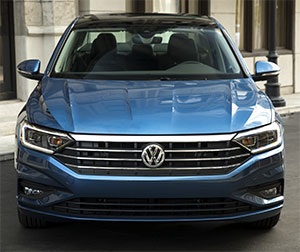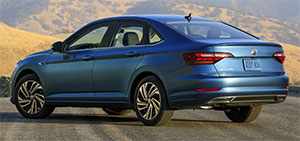2019 Volkswagen Jetta
Volkswagen needs you…and a lot of other Americans…to reach their goal of 5% U.S. market share. It’s about 2% today. Their new atlas and Tiguan SUVs will certainly help, but they need more. So, enter an all-new Jetta compact sedan. Now, VW says that more than ever, it was designed with Amercian buyers in mind. But in doing so, VW risks ruining what made Jetta popular in the first place. So let’s see how well VW walks that tight rope.
With over 17½ million sold since 1979, the Volkswagen Jetta is a well-recognized, global nameplate. When the last Jetta sedan debuted right around the beginning of this decade, it was part of Volkswagen’s new strategy to not only build cars in North America, but to tailor them specifically for American drivers.
What that meant was less emphasis on ride-and-handling, making space and price the priorities. That “bigger and cheaper is better” approach yielded exactly the desired results, record sales.
 For 2019, the 7th gen. Volkswagen Jetta not only doubles down on that strategy, but attempts to bring more driving excitement back into the mix.
For 2019, the 7th gen. Volkswagen Jetta not only doubles down on that strategy, but attempts to bring more driving excitement back into the mix.
While it still bears a resemblance to the conservative Passat, it’s certainly the most dynamic Jetta we’ve ever seen, and if you were expecting to hear the words “coupe-like profile”; well, they’re here.
The other usual descriptors apply as well, longer wheelbase, shorter overhangs, wider track; and cliché as it all may be, it’s hard to argue with the very handsome results.
A slicker shape is only part of what VW has done to get back some of the fuel economy lost without diesel or hybrid models. Active grille shutters up front, and while technically the same engine, the 1.4-liter turbo behind that grille is now tuned for more efficiency.
3-horsepower was lost in that transformation, now at 147; but torque remains the same at 184 lb-ft.
Furthering the theme, base cars get an extra gear for a 6-speed manual, and the optional automatic is now an 8-speed.
 The results are improved Government Fuel Economy Ratings of 30-City, 40-Highway, and 34-Combined; the same regardless of transmission.
The results are improved Government Fuel Economy Ratings of 30-City, 40-Highway, and 34-Combined; the same regardless of transmission.
While far from flashy inside, the exaggerated tilt of the center stack, sets a more driver-oriented tone to the space; and there’s much less hard plastic to be found, leaving nothing much to complain about.
And impressive features like the digital dash won’t be found anywhere else in this segment.
Top SEL Premium trim will also get you leather seats, both heated and ventilated; a new 8-inch Discover Media infotainment with navigation; selectable drive modes, and a 10-color LED ambient lighting system.
There is indeed plenty of space inside to get comfortable, no matter whether you’re the driver or just along for the ride. And cargo space is plentiful as well, at 14.1 cubic-ft.; 60/40 split-folding seatbacks are standard.
 Our early drive time came around Raleigh, North Carolina; and we’ll jump right in with talk of the suspension. Yes, a torsion beam is back at the rear on all trims. And while it’s easy to complain; for American Jetta buyers, it’s likely the ideal blend of capability with great everyday comfort.
Our early drive time came around Raleigh, North Carolina; and we’ll jump right in with talk of the suspension. Yes, a torsion beam is back at the rear on all trims. And while it’s easy to complain; for American Jetta buyers, it’s likely the ideal blend of capability with great everyday comfort.
And, it keeps costs down. Helping offset that is the fact that that torsion beam is now bolted to VW’s MQB architecture. Does it provide A4-like sport sedan agility? Not quite. Is it a sensibly entertaining everyday compact sedan? We’d say yes and then some. Certainly more lively than segment leaders Honda Civic and Toyota Corolla.
The new 8-speed automatic stays very busy managing power delivery from the little 1.4-liter; but it does so without undo effort. Sporty R-Line trim has no any added power, but it does get an XDS electronic differential, unique wheels, black trim, and dual exhaust tips.
VW is certainly attempting to attract your bucks by delivering as much bang as possible; very well equipped base S trim starts at $19,395, down 100 bucks from last year; top trim SEL Premium goes for $27,795. Plus, VW’s new People First warranty includes bumper-to-bumper protection for 6 years or 72,000 miles.
It would be foolish to expect the 2019 Volkswagen Jetta alone to put the brand’s sale’s goal within reach. But, it is another correct step in that direction. VW has walked the tight rope well. So, if you’re thinking about a compact sedan, with Corolla and Civic on your list, we think you should add the very entertaining VW Jetta at the top.
Specifications
- Engine: 1.4 liter
- Horsepower: 147
- Torque: 184 lb-ft.
- EPA: 30 mpg city / 40 mpg highway
2025 Volkswagen ID. Buzz
Volkswagen Brings Beetlemania Level Of Excitement To Minivan Segment
The duty of upholding Volkswagen’s heritage has most recently been delegated to small legacy car names like Golf and Jetta. But hold on! A much larger, totally modern take on VW’s classic microbus has just buzzed over the horizon— the all-electric ID. Buzz. It’s been at the top of our minds since we first saw the concept back in 2017. Well, it’s finally here, so let’s get our groove into drive!
This 2025 Volkswagen ID. Buzz has indeed created the most buzz around Volkswagen since the Beetle’s return to the U.S. in the late 1990s. We couldn’t drive it anywhere without drawing a crowd. No wonder, just about everyone has a VW Microbus story to tell, and seeing this reimagined version rolling down the street brings back all those memories.
VW really pulled it off as far as we’re concerned, as it looks great without appearing over the top. All the cues are here: Big VW logo front and center, lots of greenhouse including A-pillar windows and mini sliders for the second-row passengers, D-pillar air vents, and two-tone wheels. And while its appearance may be pure retro, its drivetrain is far from it, as the ID. Buzz is all-electric, and unlike the new Beetle, the Buzz does retain the original Microbus’ rear-drive architecture.
Powering those rear wheels is a 210-kW motor drawing juice from a 91-kWh battery for a range of 234 miles; 200-kW max charging will get you to 80% in about 26 minutes. Buyers can add another small 80-kW motor up front for 4motion all-wheel-drive and an increase of total output from 282 to 335 horsepower with a combined 512 lb-ft of torque. It uses the same battery, but range estimates drop just slightly to 231 miles. But while those numbers are modest, we also found them to be quite conservative, as we observed as many as 287 miles available in our all-wheel-drive tester’s gauge display and were on pace for 273 miles in our driving loop.
One throwback theme that may be a turnoff to some is that it’s quite a step up into the Buzz’s front seats, but there’s certainly a commanding view of the road once you climb in. Second row seating can be either a three-place bench or a pair of captain’s chairs, so there’s generous room for seven or six passengers. The captain’s chairs in our Pro S Plus offer good support and very easy access to the third row.
Lots of flexibility too with the option to simply fold the seats or remove them altogether.
With the sliding side doors and a wide opening rear hatch, there’s plenty of access for loading big sport utility amounts of cargo. Lots of flexibility too with the option to simply fold the seats or remove them altogether, and the ability to create a full-length flat floor with a rear cargo shelf that covers some handy removable storage bins. There’s 18.6 cubic-feet of space behind the third row, 75.5 behind the second, and a max of 145.5. That’s more than a Chevrolet Tahoe. For smaller items, there are lots of cubbies throughout the cabin, along with a standard Buzz Box that can be moved to multiple locations.
With a design that prioritizes retro form and modern function over aero efficiency, the 4motion equipped ID. Buzz earns a Fair efficiency rating, using 42-kWh of electricity per 100 miles, and we weren’t sure what to expect at our Mason Dixon test track.
What we found was great torque off the line and drama free launches to 60 in just 5.3 seconds. It was very stable at speed and power delivery stayed steady most of the way down the track until we reached about 90 mph, when it began to taper off just before we finished the quarter-mile in 14.0 seconds flat at 97 mph.
With 1,200-lbs. of battery weight nestled in its 127.5-inch wheelbase, the Buzz felt planted to the pavement through our handling course. There was quite a bit of body roll to deal with, but surprisingly little understeer. In panic braking runs, pedal response was inconsistent, feeling soft at times, pushing back hard at others; but through it all, results were quite good, stopping from 60 in an average of just 108 feet.
Three interior themes are available, this Dune is the brightest, featuring coastal inspired wood optic dash décor, “gray and clay” leatherette surfaces, and a high-mounted central 12.9-inch touchscreen. Pricing starts with a rear-wheel-drive Pro S at $61,545; this Pro S Plus begins at $65,045, add another $4,500 for 4motion, which brings a few extra features along with all-wheel drive.
Retro design with old-school VW charm, modern EV drivetrain, big SUV capacity merged with minivan flexibility; it all comes together in this 2025 Volkswagen ID. Buzz. It’s easily one of the coolest rides of the year and one that will likely keep Volkswagen dealers buzzing for years to come, and that’s something no other people and things mover can say.
Specifications
As Tested
- Motor Setup: Dual-Motor AWD
- Battery Size: 91-kWh
- Horsepower: 335
- Torque: 512 lb-ft
- EPA Range: 231 miles
- 0-60 mph: 5.3 seconds
- 1/4 Mile: 14.0 seconds at 97 mph
- Braking, 60-0: 108 feet
- MW Test Loop: ~ 273 miles













































